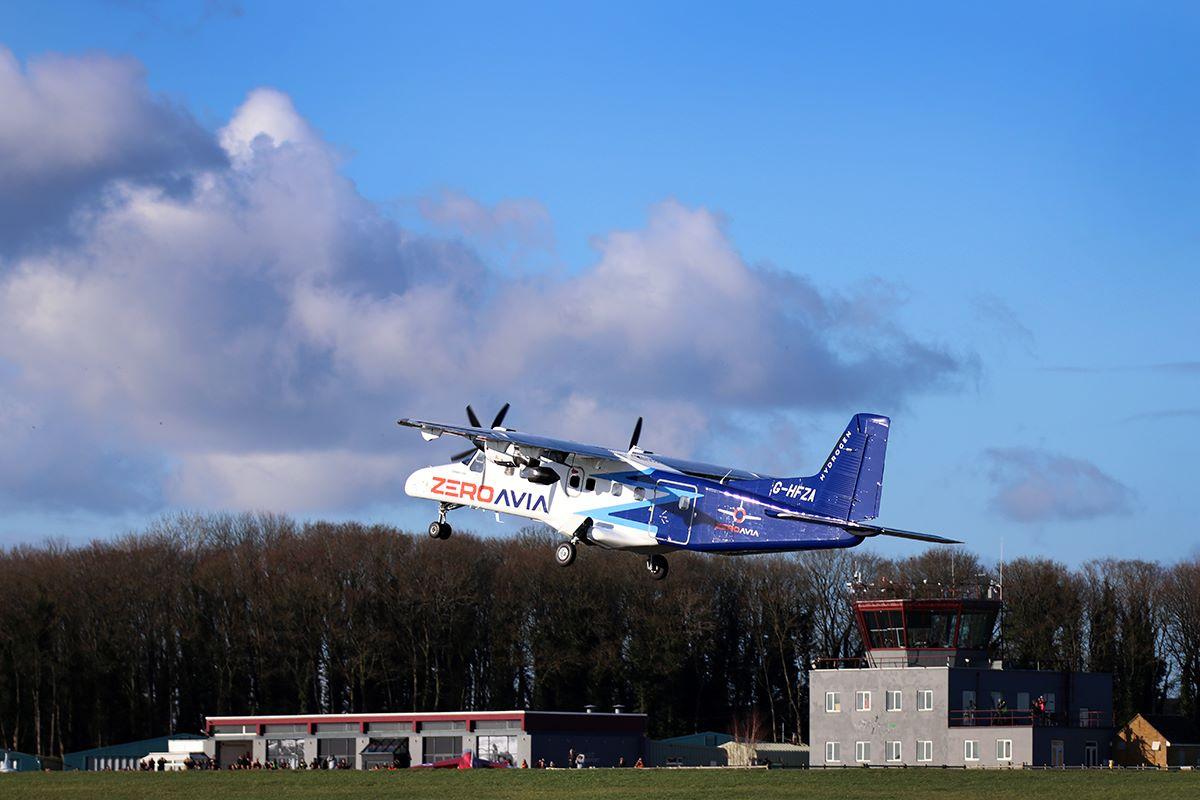
Propulsion startup ZeroAvia conducted the first flight of its hydrogen-electric powertrain on a Dornier 228 testbed from Cotswold Airport, England, on Jan. 19.
The aircraft flew for 10 min. with the 600-kW ZA600 fuel-cell propulsion system replacing the 19-seat regional turboprop’s left-side turboprop.
With a weight at takeoff of 5,650 kg (12,450 lb.), the modified 228 is the largest and heaviest aircraft yet to fly with hydrogen-electric propulsion. ZeroAvia previously flew a 200-kW demonstration system in a converted six-seat Piper Malibu.
On its first flight, ZeroAvia’s 228 reached 2,000 ft. and 120 kt with 50% of the power for the left-side electric motor coming from the fuel-cell system and 50% from batteries. Gaseous hydrogen tanks and fuel-cell stacks are installed in the fuselage.
Rival Universal Hydrogen on Jan. 18 tweeted video of its hydrogen-electric testbed—a 50-seat De Havilland Canada Dash 8-300 with a 1-megawatt fuel-cell system replacing the right-side turboprop—conducting the first propeller spin ahead of its planned first flight at Moses Lake, Washington.
ZeroAvia plans an initial campaign of 10-20 flights to validate fuel-cell operation up to the 35-min. duration demonstrated during ground endurance testing of the ZA600. Beyond that, the startup plans to work to extend the flight envelope and endurance beyond that approved under its initial permit to fly from the UK Civil Aviation Authority (CAA), says founder and CEO Val Miftakhov.
Later in the test program, ZeroAvia plans to fly the 228 with the electric motor fully powered by the fuel cell system. The certified hydrogen-electric powertrain will only use the fuel-cell for power, he says. Results from the initial test campaign will feed into final iteration of the design of the engine that will be submitted to the CAA for certification toward the end of this year.
ZeroAvia expects to announce soon the launch application for the ZA600, in the 9-19-passenger class. Deliveries are planned to begin in 2025. A manufacturing site will be selected in 2023 with small-scale series production to begin in 2024. ZeroAvia has 600-700 pre-orders for the ZA600, he says, and has already signed a contract with Sweden’s PowerCell for serial delivery of fuel-cell stacks.
The startup is working with the UK CAA to establish the certification basis for the ZA600 but needs the regulations to be harmonized with the European Union Aviation Safety Agency (EASA) and FAA “as we are not targeting a single country for the entry into service,” says Gabriele Teofili, head of aircraft integration and testing at ZeroAvia.
The UK CAA will be the primary certification authority, but ZeroAvia is aiming for concurrent EASA and FAA validation. “There is a lot of attention to our certification basis and to have a common UK and EASA certification, but it’s not enough for us because we cannot launch only in Europe,” Teofili says. “So, we will also pull the FAA toward the same schedule. We need to have a full harmonization.”
ZeroAvia will ask customers to start placing deposits for ZA600 delivery slots this year, Miftakhov says.
The startup is also developing a 2-megawatt-class system for 70-80-seat regional turboprops. This will use cryogenic liquid hydrogen storage. Component testing is under way and integrated ground tests are expected to begin “in a few weeks,” he says. The balance of ZeroAvia’s approximately 1,500 pre-orders are for this larger ZA2000 system.
The startup is working with more than 10 airports to prepare for the deployment of hydrogen-powered aircraft by its launch customers. “We believe the best approach is on-site production of hydrogen by electrolysis,” as it avoids the transportation of fuel over long distance, says Miftakhov. “This is the most economical way to produce fuel and also the fastest way to deploy such infrastructure.”

